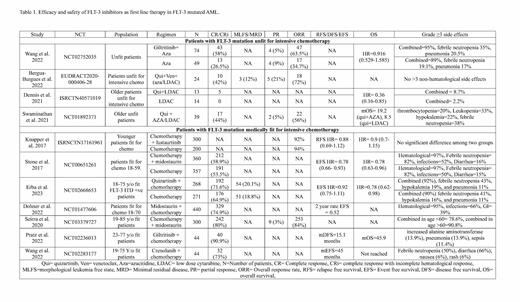Introduction:
FMS-like tyrosine kinase 3 (FLT-3) is the most commonly reported gene alteration in acute myeloid leukemia (AML) patients and is associated with relatively poor survival outcomes and response rates. Multiple FLT-3 inhibitors were tested in combination with standard first line therapy in recent years in both medically fit and unfit patients for intensive chemotherapy. In this systematic study, we will assess the efficacy and safety of FLT-3 inhibitors in newly diagnosed patients with AML.
Methods:
A literature search was performed on PubMed and Embase with keywords for, “FLT-3 mutations” AND “AML” from the inception of data till 6/31/23. PRISMA guidelines were followed while conducting this systematic review. We screened 5,983 articles and included 5 randomized clinical trials (RCTs, N=1,906) and 6 non-randomized clinical trials (nRCTs, N=891) based on inclusion criteria.
Results:
In 11 clinical trials (N=2,797), 233 patients were unfit for intensive chemotherapy while 2,464 were fit for intensive chemotherapy. 1,906 patients were treated with FLT-3 inhibitor-based regimens while 891 patients were treated with standard therapy. In an RCT by Wang et al. (N=123) on unfit patients, CR/ORR were 58%/63.5% with giltritinib (Gil)+ azacytadine (Aza) vs. 26.5%/34.7% with Aza. Hazard ratio (HR) for overall survival (OS) was 0.9, similar in two groups. In subgroup of an RCT by Dennis et al. (N=27), HR of OS was 0.36 (0.16-0.85) significantly in favor of quizartinib (Qui) + low dose cytarabine (LDAC) vs. LDAC alone. In two nRCTs (N=63) on unfit patients, Qui + venetoclax (Ven) +Aza/LDAC showed complete response (CR)/overall response (ORR) of 42%/72% and Qui+Aza/LDAC showed CR/ORR of 44%/56%. In an RCT by Stone et al. (N=617) on fit patients up to 59 years old, CR/CRi was 58.9% and 53.5% with midostaurin (Mid)+ chemotherapy and chemotherapy, respectively. HRs of event free survival (EFS) and OS were 0.78 (0.66- 0.93) and 0.78 (0.63-0.96), respectively, significantly in favor of Mid+chemotherapy as compared to chemotherapy alone. In two nRCTs (740) including older fit patients up to 85 years of age, CR/CRi was 77% with no new safety signal. In an RCT by Erb et al. (N=539), CR/CRi was 71.6% and 64.9% with Qui + chemotherapy and chemotherapy, respectively. HRs of EFS and OS were 0.92 (0.75-1.11)* and 0.78 (0.62-0.98), respectively, in favor of Qui + chemotherapy (*not statistically significant). In an RCT by Knapper et al. (N=500) on fit patients, HRs of relapse free survival (RFS) and overall survival (OS) were 0.88 (0.69-1.12) and 0.9 (0.7-1.15), respectively, with no significant difference among lustaurtinib (Lus) + chemotherapy vs. chemotherapy alone. In two RCTs (N=88), CR/CRi was 90.9% and 73% with Gil+chemotherapy and crenolanib (Cren) + chemotherapy, respectively. Table 1. ≥3 grade 3 hematological and non-hematological side effects are given in table 1.
Conclusion:
Addition of Gil, Qui, Lus, Mid, or Cren to standard therapy was well tolerated by most of the patients with FLT-3 mutation. Addition of Mid or Qui to chemotherapy significantly improved survival and response rates as compared to chemotherapy alone in fit patients with FLT-3 mutation and the results were consistent in both young and old fit patients. In early phase trials, Gil and Cren were effective in combination with chemotherapy in fit patients. In subgroup analysis of an RCT, Qui significantly improved survival and response rates in FLT-3 mutated unfit patients in combination with LDAC. Gil and Lus failed to improve survival in FLT-3 mutated unfit and fit patients, respectively. More randomized double-blind multicenter phase III clinical trials are needed to confirm these results.
Disclosures
No relevant conflicts of interest to declare.


This feature is available to Subscribers Only
Sign In or Create an Account Close Modal